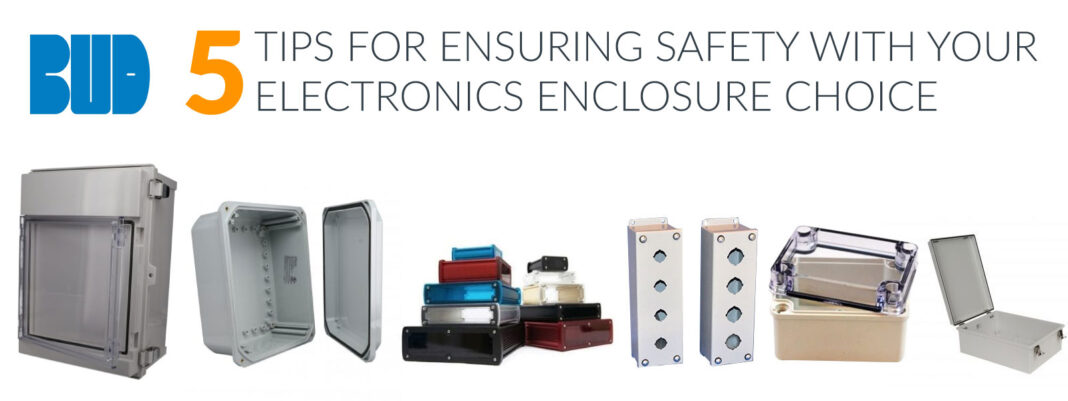Five Tips for Ensuring Safety with your Electronics Enclosure Choices
TestEquity is an approved distributor for Bud Industries.
Content Source: https://www.budind.com/article/five-tips-for-ensuring-safety-with-your-electronics-enclosure-choice/
It is always a “truism” of safety that the best way to be safe is to prevent problems. This can range from testing your tire pressure regularly to making sure your home smoke detector has updated batteries. In an industrial setting, this is even more important because the safety of those who work or live nearby can be impacted by poor preparations. With electronic and electrical enclosures, it is important to make the right choices both for equipment that is used to verify safety (meters, monitors, etc.) but also for controls. A poor choice in control enclosures can endanger the equipment and the operators as well. Below are five tips for ensuring safety with your electronics enclosure choices:
1. Be sure to choose an electronics enclosure made from the proper materials.
There are many materials that are available for enclosures in the electronics and electrical marketplace. Each has advantages and disadvantages ranging from price to durability. In the safety world, price cannot be the only driver, but security and longevity are crucial. For example, in an environment with harsh chemicals, the low cost solution of polycarbonate plastics may not be the best choice, but rather steel or other metal enclosure may be more appropriate. For an outdoor installation, it is important that any plastic is UV stabilized. Other material factors include the product weight if it will be portable, finishing options if the product will be used in a visible location, and durability which might lead to the use of fiberglass versus polycarbonate.
2. Be sure to choose an electronics enclosure with the proper ratings.
Do you need specific ratings on the enclosure or can you utilize the unit without those ratings? For example, does the unit need a UL rating or is the manufacturer’s NEMA ratings sufficient? Bud offers a NEMA enclosure line with several alternatives included an ABS plastic version that does not come with the UL ratings. It protects the product, but is lower cost than those that receive the UL ratings. For most applications, this box provides a perfect solution of value and function. In a similar vein, can you use a box with a lower level of protection? For example, a NEMA 1 box may suffice where traditionally one has used a NEMA 12 box (see side bar for NEMA description). Alternatively, if only a specific internal component needs to be EMI/RFI shielded, it is better to protect that component than to shield the entire enclosure.
3. Be sure to choose an enclosure that can be mounted readily in the location that you need.
If you were to buy a plastic enclosure that needed to be mounted to a piece of equipment, you do not want to deal with putting holes in the enclosure, disrupting your equipment, if it does not have mounting provisions. The same is true for most enclosures. In addition, be sure that there are provisions internally for mounting your equipment. Whether it is mounting bosses such as those inside a die cast or plastic box, or mounting panels that are found within a steel or fiberglass box, it will disrupt your project if this is not considered. Also, a factory solution ensures that your mounting approach is safe and logical.
4. Be sure that the electronics enclosure box can handle the weight of the equipment you are seeking to mount.
While your PC boards are typically lightweight, if you are mounting test equipment into a 19″ cabinet rack, will the rails and also the casters hold the weight that you need within the enclosure? Be sure to verify the weight load characteristics before you attempt to install your servers or test equipment. In smaller electronic component enclosures, weight load is also important to be sure that you are not attempting to load more components than the box can handle. From a safety perspective, the security of your installation can be compromised with improper preparation for the weight of your components.
5. Be sure to ask the electronics enclosure manufacturer for a quote with modifications.
Very few enclosures can be used as is. Typically they need holes or slots for input and output, silk screening for directions or notes, and other such alterations to make them usable. While it would seem that anyone can punch a hole in a box, using the wrong drill speed or size can cause cracks or chips which ruin the integrity of the electronic enclosure box. In some situations, the modifications can be made before forming, -reducing the risk of mis-alignment or other errors. Further, it reduces the risk of transportation damage with less handling. Even if it seems inexpensive to have the work done internally, it will often prove more costly in the long run if it is not done correctly.
While the enclosure is a “low tech” purchase in the high tech world, when it comes to safety, the risks should not be underestimated. Simple advance preparation can make sure that your safety and the safety of your equipment will be guaranteed and operate as expected.
Reach out to our team of technical experts with any questions.



